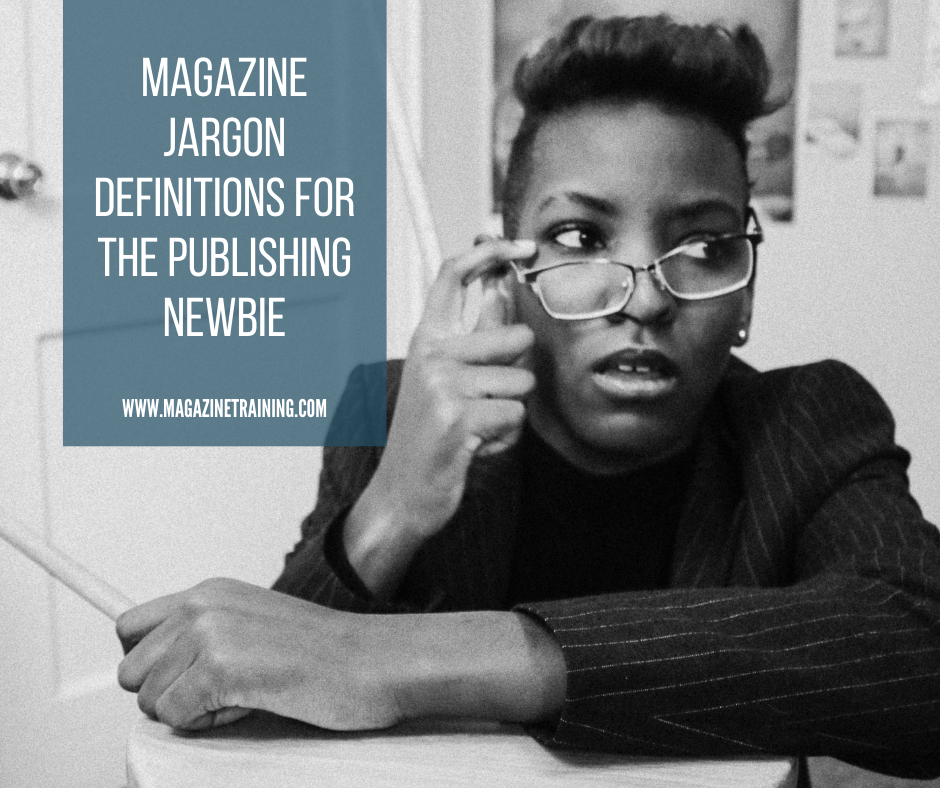
If you are new to magazine publishing you may hear a bunch of terms that you are not familiar with. Here is a list of common jargon and their definitions to help get you started:
Bleeds: If type or imagery extends beyond the trim edge of a page it is called a bleed.
Callout: A quote from the article printed in large type. It is usually placed on the second or subsequent spread of an article. Callouts serve as a design element and create reader curiosity about the article content. This is also referred to as a pull-quote.
Cutline: Another term for a caption used to describe or annotate photographs and illustrations in a magazine.
Department: Features you want covered in each issue that have a more consistent and identifiable format from issue to issue.
Dropcap: This is sometimes included in the opening paragraph of a magazine article, it is a relatively large, one-letter design element (usually a capital letter, and usually the first letter of the opening word of the paragraph) that “drops” down alongside several lines of copy in that paragraph. It is used for aesthetic appeal and to draw the reader’s eye.
Editorial: All non-advertising content in a magazine issue.
Eyebrow: A text/design element often used at the tops of article pages which give readers a quick look at a magazine’s content; mostly placed above the name plate.
Feature: A special or prominent article in a magazine. The cover story is usually considered to be one of the feature articles, but an issue may contain several other features as well.
Folio: The information at the bottom of most non-advertising magazine pages, often including the page number, magazine title and issue name.
Fractional ads: A generic name for ads smaller than 1/2-page (e.g., 1/3, 1/4, etc.).
Gutter: The inside margin where two pages of a publication join.
Kerning: A design-specific term for the spacing between letters. Kerning can be adjusted narrower or looser, depending on space needs and limitations.
Layouts: The arrangement of text and graphics on a page or spread.
Leading: The spacing between lines of text. It can be adjusted as needed.
Masthead: A small section of the magazine, usually located near the front, containing a list of magazine staff and contributors, issue volume/number information, copyright information, ISBN information, legal notices, etc.
Nameplate: The logo.
Perfect binding: A binding process in which the gutter edges of the interior of the magazine are ground down a bit, coated with adhesive, and bound to the sheet containing the covers and spine. Ask your printer if your magazine has enough pages for perfect binding to be a good option.
Resolution: This refers to the amount of detail a digital image holds. Printers recommend “high-resolution” or “high-res.” Images with lower resolutions may appear pixelated in print. Medium-res images are often suitable for online flipbooks and digital editions, and low-res images are standard on websites.
Saddle-stitching: In saddle-stitch binding, the magazine is laid flat, then stapled from the outside (cover) toward the inside (centerfold), then folded to the final size. Ask your printer if this type of binding is appropriate for your magazine because it has an upper page limit depending on the stock used.
Sidebar: A short article related to the main article and placed next to it.
Spine: For perfect-bound magazines, the spine is the strip of cover between the front and back covers. Often contains the magazine title, issue volume/number, etc
Spreads: A design or article that extends across the two pages of a magazine that face each other.
Stock: Alternative term for paper.
Stock images: Photography and illustrations that can be purchased/licensed through various websites. Stock can be very helpful in cases where hiring a photographer for a custom photo shoot is impractical/unaffordable.
Typography: Refers to the use of various fonts/typefaces and the style and arrangement of the headline and subhead letters on a page.
White space: The blank areas of the page. Good design provides for deliberate use of white space. Also known as “negative space.”
Purchase one of our manuals that cover writing, design, management, and editing. Each manual contains an extensive glossary of terms.
Click here for more definitions.
Related posts
Magazine Training International’s mission is to encourage, strengthen, and provide training and resources to Christian magazine publishers as they seek to build the church and reach their societies for Christ.

